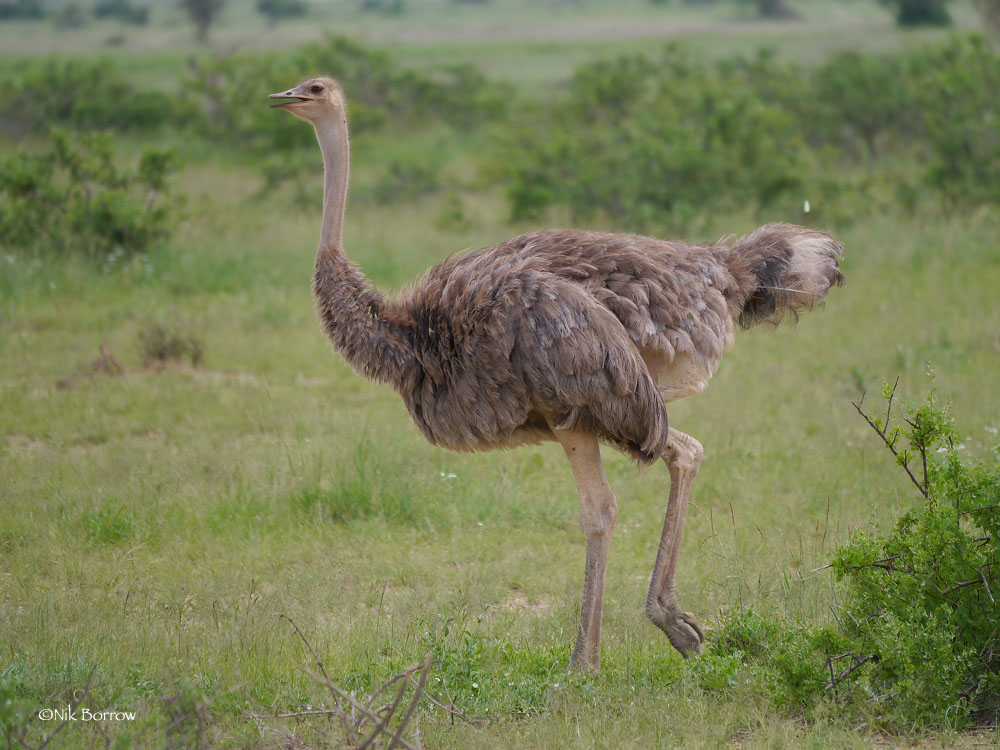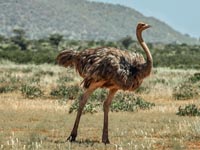The ratites, are a diverse group of flightless birds. They include the Cassowary and Emu of Australasia, the Kiwi of New Zealand, the Ostrich of Africa, and the Rhea of South America. Unlike other flightless birds, the ratites have no keel on their breastbone, that is, it is flat. Without this keel to anchor their wing muscles, they could not fly even if they were to develop suitable wings. Their legs are strong and don't have air chambers, except for femurs. Like humans that do a lot of walking, all ratite toes face forward. All ratites except the ostich have three toes; the ostrich has two. The closest living relatives of the ratites are the tinamous of South America. The tinamous do have a keel on their sternum so they are able to fly, but not very easily.
The ratites and the tinamous belong to the minority of birds where the male has a penis. The only others with this feature are the landfowl (Galliformes) and waterfowl (Anseriformes), The bird penis uses lymphatic fluid for the erection process instead of blood.
The different raritite groups are described below. At one time all of these ratites were considered to belong in one order, Struthiornithiformes. Currently, only the ostriches are assigned to that order. The cassowary and emu are in the same order. The kiwi and rhea each are assigned to their own roder.
Order Apterygiformes Family Apterygidae KIWI
The kiwis, which are only found in New Zealand, are classified as ratites - flightless birds without a keel on its sternum for attachment of wing muscles. The ancestor of kiwis probably flew to New Zealand. After their arrival, an offshoot evolved to be the flightless kiwi. Kiwis are approximately the size of a chicken, However, a kiwi egg is nearly six time the size of a chicken egg. That large size allows a kiwi chick to be mobile shortly after birth and relatively well developed.
The kiwi feather is long, thin, and hair-like. Their vestigial wings are so small they are hidden beneath their feathers; and likewise they do not have tail feathers. Just as flightlessness has allowed kiwi to evolve to have very large eggs, it also allows them to have heavy bones with marrow in them. Another uncommon feature of kiwis, as is true for most rartite, is that they have no "preen gland" (uropygial gland). The uropygial gland is strongly developed in many waterbirds such ducks. On the other hand, flightless rartites are not the only bird groups that do not preen. Woodpeckers are another example.
The nest is located in a burrow created by the birds, or a natural cavity. Because the female kiwi produces such a large egg (infrequently 2 eggs), there are a number of ramifications. The female kiwi is bigger than the male so she has more room for that huge egg. Because the eggs is so large, she does not eat for much of the gestation period because she doesn't have room for food. By the time the egg is laid she has lost a lot of weight. In some kiwi species, the male compensates for her weight loss by being the main incubator of the egg which gives her time to recover. In other species the female may participate with the incubation, or there might be helpers.
Kiwis are the only birds that have their nostrils at the end of their bill. This allows them locate prey by smell better than most other birds. Since sight is not crucial to finding prey, kiwis have evolved to be nocturnal which gives them a degree of protection from predators. When kiwis first evolved, there were no mammals other than bats in New Zealand; thus kiwis were able to thrive. Unfortunately, for hundreds of years, numerous mammal species have been introduced to the islands. Stoats, a small weasel, take kiwi eggs. Dogs and cats are threats to adult kiwis. To help kiwis survive, "Operation Nest Egg" takes kiwi eggs from nests, incubates them, and raises the chicks until about 1200 grams at which time they are released into the wild. A chick thus protected has a much better chance of survival than one that is raised exclusively in the wild. Kiwis have been known to life for up to 50 years.
Genus Aperyx
Kiwi, Great Spotted Apteryx haastii Found: Forests of
Description: The great spotted kiwi has brown plumage with light barring. They used to be more widespread, but those remaining are between found at 700 to 1100 meters where they do not have many predators. It isa large kiwi, up to 60 cm long. The female is bigger and has a longer bill than the male. They are monogamous.
Range: South Isand, New Zealand.
Habitat: Grasslands, scrublands, pasture, forests. They may construct up to 50 burrows, and daily move from one to another for security reasons.
Diet: Worms and grubs which they find underground. Insects and spiders which they find above ground.
Conservation status: It is listed as Vulnerable with a declining population from dogs, cats, ferrets, stoats.
Image by: 1) John Gerrard Keulemans Range: South Isand, New Zealand.
Habitat: Grasslands, scrublands, pasture, forests. They may construct up to 50 burrows, and daily move from one to another for security reasons.
Diet: Worms and grubs which they find underground. Insects and spiders which they find above ground.
Conservation status: It is listed as Vulnerable with a declining population from dogs, cats, ferrets, stoats.

Kiwi, Little Spotted Apteryx owenii
Description: The little spotted kiwi has brown plumage with faint barring that can appear to be spots. It is the smallest of the kiwis at 35 to 45 cm long with the female larger than the male.
Range: Kapti Island, New Zealand.
Habitat: Forests; also scrubland and grasslands.
Diet: Grubs and other insects that are found underground. They dig up the ground with their feet and biil, then use the bill via its strong sense of smell to find the prey.
Conservation status: Least Concern.
Image by: 1) Kimberley_Collins 2) Judi_Lapsley_MillerRange: Kapti Island, New Zealand.
Habitat: Forests; also scrubland and grasslands.
Diet: Grubs and other insects that are found underground. They dig up the ground with their feet and biil, then use the bill via its strong sense of smell to find the prey.
Conservation status: Least Concern.
1) Juvenile


Kiwi, North Island Brown Apteryx mantelli
Description: The North Island brown kiwi has brown plumage with some streaking. It is the only kiwi found on the North Island of New Zealand and is the most common of all the kiwis. The North Island brown kiwi is 50 to 65 cm long with the female larger than the male. Because the female does not eat and much of the gestation and thus loses a lot of weight, the male is the sole incubator of the eggs and that takes up to 85 days.
Range: North Island, New Zealand.
Habitat: Wet forests and shrublands; also plantations, pastures.
Diet: Insects, spiders, other arthropods.
Conservation status: It is listed as Vulnerable due to declining population.
Image by: 1) The Rohit - Rainbow Springs Wiki Wildlife Park, New ZealandRange: North Island, New Zealand.
Habitat: Wet forests and shrublands; also plantations, pastures.
Diet: Insects, spiders, other arthropods.
Conservation status: It is listed as Vulnerable due to declining population.
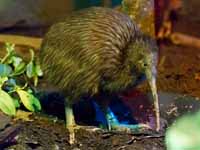
Kiwi, Okarito Apteryx rowi Found: Okarito Forest on west coast of New Zealand's South Island
Description: The Okarito kiwi , also known as the Okarito brown kiwi, has brown plumage with some grey on the head and belly. The female lays her eggs in different nests. Both the male and the female incubate the eggs. The Okarito brown kiwi is about 55 cm long. The Operation Nest Egg program, which takes eggs - incubates - raises chick - release in wild, has increased wild population from about 200 to 600!to It differs from the similar southern brown kiwi by having some grey on its head and belly.
Range: Restricted area of the Okarito forest on the West Coast of New Zealand's South Island.
Habitat: Dense forest near the coast.
Diet: No data.
Conservation status: It is listed as Vulnerable as its population is declining due to habitat loss and stoats taking eggs. But see above for success of Operation Nest Egg.
Image by: 1) Mark_Anderson 2) Dept_ConservationRange: Restricted area of the Okarito forest on the West Coast of New Zealand's South Island.
Habitat: Dense forest near the coast.
Diet: No data.
Conservation status: It is listed as Vulnerable as its population is declining due to habitat loss and stoats taking eggs. But see above for success of Operation Nest Egg.
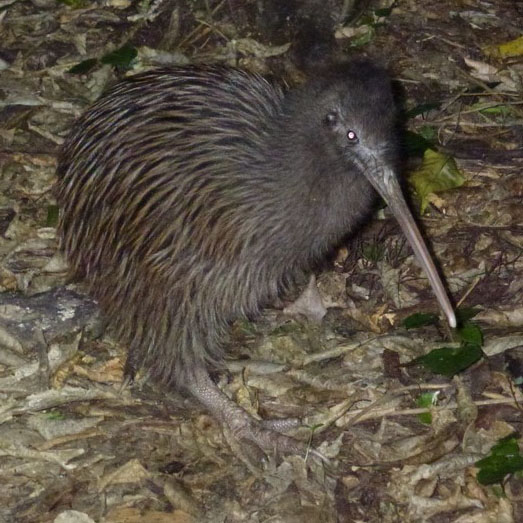

Kiwi, Southern Brown also Common Kiwi Apteryx australis
Description: The southern brown kiwi, also known as the common kiwi, has rufous plumage with some streaking.
Range: Stewart Island, New Zealand and southwest South Island.
Habitat: Forests, grassland, shrubland. They prefer dense vegetation.
Diet: Insests, larvae, snails, earthworms.
Conservation status: It is listed as Vulnerable because of predators. Steward Island may be predator free, but there are worries that stoats have arrived.
Image by: 1, 2) Smithsonian's National Zoo 3) Glen Fergus - Stewart Island, NZ 3) wbnzRange: Stewart Island, New Zealand and southwest South Island.
Habitat: Forests, grassland, shrubland. They prefer dense vegetation.
Diet: Insests, larvae, snails, earthworms.
Conservation status: It is listed as Vulnerable because of predators. Steward Island may be predator free, but there are worries that stoats have arrived.



Order Casuariiformes Family Casuariidae CASSOWARY
The Casuariidae family only has one living genus, the cassowaries. They are shy (wary) birds of the deep forest that have a bony casque on top of the head. Combining "casque" plus "wary" leads to the name of such a bird - cassowary. They are found mainly in New Guinea, but also the Aru Islands of Indonesia and northeastern Australia. They are classified as ratites - flightless birds without a keel on its sternum for attachment of wing muscles.
Cassowaries have shiny feathers. The shine of most" bird's feathers comes from their barbules, which interconnect to create a surface that can push the air to fight gravity. The flightless cassowary doe not have much use for barbules so they are pretty sparce which allows the central spine of the feather, the rachis, to be visible. It is the shiny rachis that gives gloss to the cassowary plumage.
As for the cassowary's casque, there are different theories of it use. It is made from a keratinous material similar to the material in finger nails. The interior of the casque is a network of fibers that provides support such a scaffolding. The casque thus, at least to some extent, serves as a helmet for the cassowary as it passes through thickets. Another suggested use for the casque is to aid in sound production. The cassowary call has the lowest tone of any bird call! To help this call propogate for large distances, perhaps the casque interior acts as a resonating chamber.
Another attention getting attribute of the cassowary is its size. they are the forth heaviest bird species, coming after the 2 ostrich species and emu in weight. The female southern cassowary can reach 2 meters in height and almost 60 kg; males are a little smaller. But the ostrich can attain 150 kg, and 2.8 meters in height. That said, the cassowary is said to be the most dangerous bird in the world! At the end of their long and study legs they have big feet. The three toes all face ford and the middle toe has a pointed daggar-like claw. Driving that claw into an enemy's stomach or neck could be fatal. The long legs allow a casswary to run fast, up to 50 km per hour. The fastest bird on land is the ostrich at 70 km per hour which is close to the speed of the fastest horse. They can jump up to 1.5 metres and they are good swimmers, crossing wide rivers and swimming in the sea as well.
Another uncommon feature of cassowaries, as is true for most rartite, is that they have no "preen gland" (uropygial gland). The uropygial gland is strongly developed in many waterbirds such ducks. On the other hand, flightless rartites are not the only bird groups that do not preen. Woodpeckers are another example.
Cassowaries have an opportunistic diet. Mainly fruits, but also fungi, flowers, insects, snails, frog, fish, bats, ... ! They eat the food seeds and all and thus help propogate and disperse the plant.
The female lays her eggs in a nest prepared by the male. She may then leaves him to go to other male's nest to lay some more eggs! As implied by this behavior, it is the male that incubates the eggs and cares for the chicks. That role reversal of the sexes does not surprise the male, as during courtship one part of the ritual is for the female to chase the male. And after copulation she may leave and seek the attentiions of another male. The average life of a cassowary is probably 40 to 50 years.
Genus Casuarius
Cassowary, Dwarf Casuarius bennetti
Description: The dwarf cassowary has stiff shiny black plumage; a small triangular casque; pink cheeks, and red patches of skin on its blue neck. It is the smallest of the cassowaries and has the shortest casque. The dwarf cassowary is up to 110 cm long and weights 17 to 26 kg. The similar southern cassowary has a large wattle at the front of its neck.
Range: New Guinea, New Britain, and Yapen Island.
Habitat: Montane forests if other cassowary species are around, else it will also inhabit lowland forests.
Diet: Mainly fruits, small animals, insects.
Conservation status: It is listed as Near Threatened because of habit loss and degradation. It is also hunted for food, even though it yields tough meat.
Image by: 1) David Cook - Papua New Guinea 2) George Bennett Gaurav NalkurRange: New Guinea, New Britain, and Yapen Island.
Habitat: Montane forests if other cassowary species are around, else it will also inhabit lowland forests.
Diet: Mainly fruits, small animals, insects.
Conservation status: It is listed as Near Threatened because of habit loss and degradation. It is also hunted for food, even though it yields tough meat.
1) Juvenile

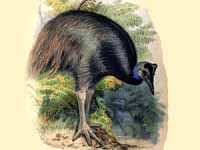

Cassowary, Northern Casuarius unappendiculatus
Description: The northern cassowary has hard and stiff black plumage. It has blue facial skin and a casque on top of the head. The neck is bright red or yellow colored with a wattle. The feet are huge and strong with a long, dagger-like claw on its inner toe. The northern cassowary is about 150 cm long and the larger female averages 58 kg which makes it the fourth heaviest bird (after the 2 ostrich species and the southern cassowary).
Range: Northern New Guinea.
Habitat: Lowland forests.
Diet: Berries, fruits, insects, small animals such as mice and frogs.
Conservation status: Least Concern. Hunting by natives is presently their largest threat.
Image by: 1) viajar24h 2) Rudiger_Stehn 3) Bernard Dupont - Chinag Zoo, Thailand 4) viajar Range: Northern New Guinea.
Habitat: Lowland forests.
Diet: Berries, fruits, insects, small animals such as mice and frogs.
Conservation status: Least Concern. Hunting by natives is presently their largest threat.
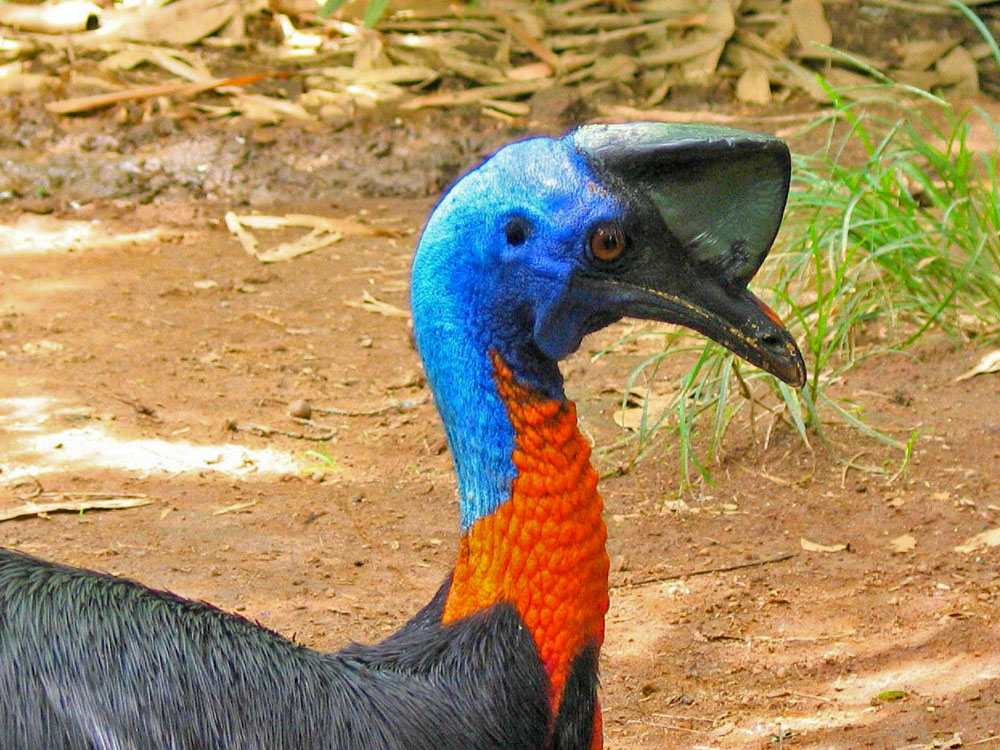
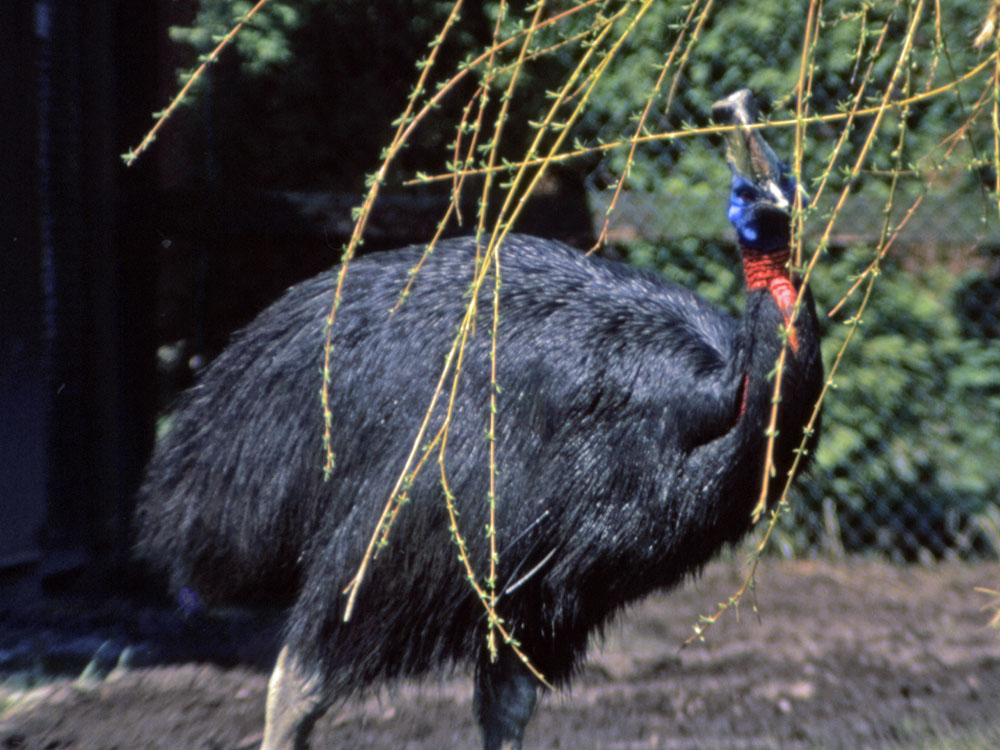
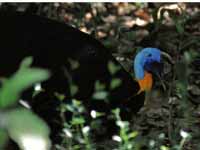

Cassowary, Southern Casuarius casuarius
Description: The southern cassowary has hard and stiff black plumage. The face and neck are blue, There are one to 3 red wattles on the neck and their length varies from bird to bird. The color of these bare parts can vary with mood. There is a large casque on top of the head. The bill is black and may have some yellow at the base. The feet are huge and strong with long, dagger-like claw on its inner toe. It is the largest of the cassowaries, up to 170 cm long.
Range: Southern New Guinea, northeastern Australia.
Habitat: Tropical rainforests, savannahs with trees, mangroves.
Diet: Fruits, fungi, insects, small vertebrates. It can eat some fruits that are toxic to other animals..
Conservation status: Least Concern.
Image by: 1) Jeff_Photoart 2) BS Thurner Hof 3) Dezidor 4) S. Shankar - Singapore ZooRange: Southern New Guinea, northeastern Australia.
Habitat: Tropical rainforests, savannahs with trees, mangroves.
Diet: Fruits, fungi, insects, small vertebrates. It can eat some fruits that are toxic to other animals..
Conservation status: Least Concern.




Order Casuariiformes Family Dromaiidae EMU
This family only has one living species, the emu. They are found in the wild only in Australia. However they are raised on farms for meat in North America and elsewhere. They are classified as ratites - flightless birds without a keel on its sternum for attachment of wing muscles. They do have vestigial wings which are about 20 cm long. Although useless for flight, they are flapped while running, perhaps for stabilization. They can attain speeds of almost 50 km when running. A normal walking stride is about 1 meter, but a running stride can approach 3 meters. The feet have 3 toes, all facing forward. The middle toe is by far the largest and can be utilized as a weapon when the emu kicks.
Emus have a secondary eyelid they don't move up-and-down, but instead move horizontally away from the bill side of the eye. The secondary eyelid helps protect from dust in dry windy regions. By utilizing these inner eyelids it can still see during adverse conditions. Unlike most other ratites, the emus do have preening glands and utilize them often. The ratites that do not have a preening gland However, that preening gland can be detrimental to an emus lifespan. The oil from those glands are used for medical and health products. The common way to get that oil for such uses is to first kill the emu.
The male emu makes the nest in a somewhat shelter depression. It is made of bark and sticks with leaves and grass to line it. The nest is usually place in a spot with a relatively good view so the male can be on the lookout for predators. The female, which in general is larger than the male, takes the lead in courting. She attracts a male by low frequency drum-like calls. She then circles the male at a distance of 10 to 30 meters with her rear facing him thus signaling her desires. If the male responds and shows interest, she still retains her right to reject him! Females will even fight other females for the right to a male. After the clutch has been laid, the female may participate in incubation, or she may go seek another mate for yet more egg production.
Genus Dromaius
Emu Dromaius novaehollandiae
Description: The emu has mainly soft brown plumage. The crown and upper neck have sparce black feathers. The male has more head and neck plumage and the female is more likely to show some bright blue facial skin. Their legs are strong and good for long distance running. There are 3 forward facing toes with claws that are are good for defense. They are polygamous and the male does most of the incubation. The emu is 150 to 190 cm tall. Emus can live over 10 years in captivity.
Range: Australia. Farmed elsewhere for meat.
Habitat: Open country, woodlands.
Diet: Insects, spiders, other arthropods, grasses and other plants, seeds.
Conservation status: Least Concern.
Image by: 1, 2, 4) Dick Daniels - Australia 3) JJ Harrison 4) Dick - San Francisco Zoo Range: Australia. Farmed elsewhere for meat.
Habitat: Open country, woodlands.
Diet: Insects, spiders, other arthropods, grasses and other plants, seeds.
Conservation status: Least Concern.
3) Female 4, 5) Male




Order Rheiformes Family Rheidae
The rheas belong to just one genus, which is appropriately name Rhea. They are found in the wild only in South America. Some have escaped from captivity in Europe and formed stable feral communitiles. They are classified as ratites - fightless birds with no keel on their breastbone, that is, it is flat. Without this keel to anchor their wing muscles, they could not fly even if they were to develop suitable wings. That said, their wings are very large for a flightless bird - the greater rhea having a wingspan of over 2 meters. The wings are alternately spread while running which helps with balance and also steering. Their top speed is about 50 km per hour. As do all the other ratites except the ostrich, the rhea has 3 toes and they all face forward. The feet are very similar to those of an emu.
At breeding time, the male rhea goes into a courting ritual. If he succeeds in mating, he will lead the female to his nest thus demonstraing where she should eventually lay their eggs. When the time comes to deposit her eggs she returns amd may find him covering the nest. She lays the egg close to the nest and he rolls it in. When all the eggs are laid, she goes off to find another mate, copulate, etc. When that process is done, she may actually seek yet another male. The males do all the incubating. If a dominant male has a helper, he will go off and impregnate another female. The average clutch size is 26 eggs, laid by 7 different females!
When the chick is ready to hatch, starts a loud popping call. That helps convince the other chicks in their eggs it is time to start hatching. Even if the eggs in the nest were two weeks apart in being deposited, they will all hatch within a few days of each other. Not only don't the incubate the eggs, the female does not raise the chicks.
Genus Rhea
Rhea, Greater Rhea americana
Description: The greater rhea have grayish-brown plumage. It has a black crown. The base of the long neck is darker for the male than the female. The underparts are pale, the legs terminate in 3 toes with the inner toe much bigger than the other two. They have large wings for a flightless birds and often spread them while running.`It is 125 to 140 cm long and average 1.5 meters tall and weight 25 kg. Sone lesser rhea may weigh about the same as a greater rhea, but the lesser is a stockier bird so it is not as tall.
Range: Argentina, Bolivia, Brazil, Paraguay, and Uruguay.
Habitat: Grasslands with the grass not high.
Diet: Broad leaf foliage, fruits, seeds, insects, fish, mice.
Conservation status: Least Concern.
Image by: 1) Frank_Vincentz 2, 3, 4) Cláudio Timm - Rio Grande do Sul, Brazil Range: Argentina, Bolivia, Brazil, Paraguay, and Uruguay.
Habitat: Grasslands with the grass not high.
Diet: Broad leaf foliage, fruits, seeds, insects, fish, mice.
Conservation status: Least Concern.
2 Female 3, 4) Male
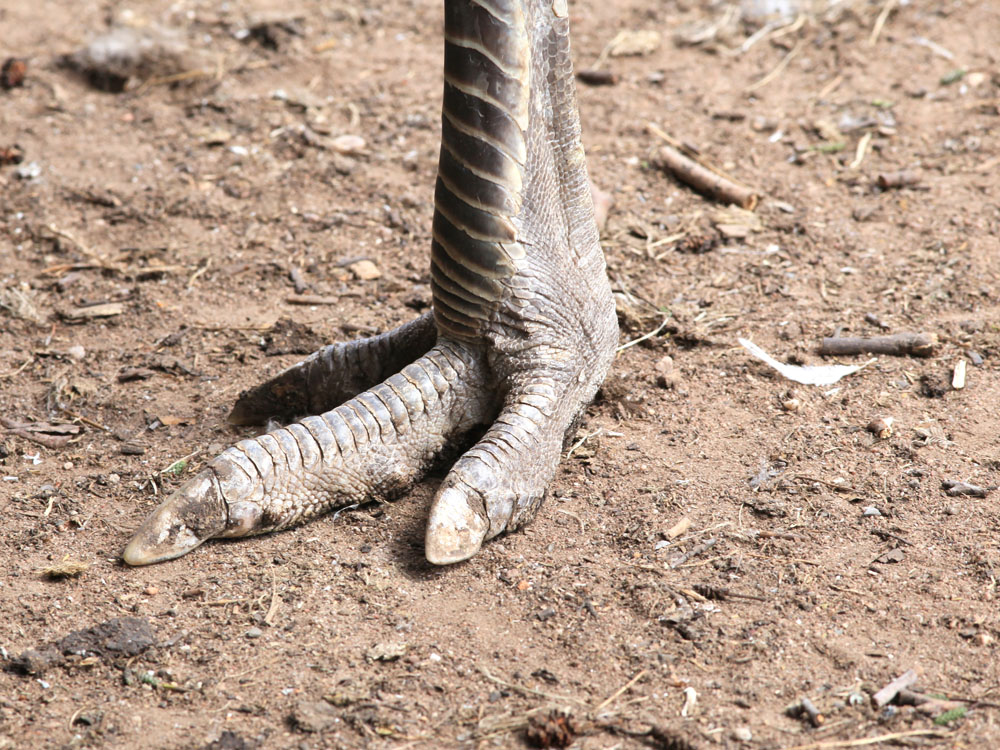


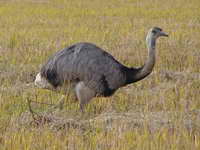
Rhea,_Lesser Rhea pennata
Description: The lesser rhea, also known as the Darwin's rhea, has brown plumage with white spots. The male has more white spots than the female. The lesser rhea is 90 to 100 cm high and about the same height. This is less than the a greater rhea, but the girth of the lesser does appear to be bigger. The greater rhea does not have white spots.
Range: Southern Peru to Argentina.
Habitat: Grasslands, bogs, desert
Diet: Saltbush, cacti fruit, grasses. Also insects, lizards.
Conservation status: Least Concern.
Image by: 1, 3, 4) Chucao - Chile 2) Jennifer Bergk 5) ValentinRange: Southern Peru to Argentina.
Habitat: Grasslands, bogs, desert
Diet: Saltbush, cacti fruit, grasses. Also insects, lizards.
Conservation status: Least Concern.





Order Struthioniformes Family Struthionidae OSTRICH
There are two species of ostrich. They both belong to the same genus and both are found in the wild only in Africa. They are classified as ratites - flightless birds with no keel on their breastbone, that is, it is flat. Without this keel to anchor their wing muscles, they could not fly even if they were to develop suitable wings. That said, their wing are very large for a flightless bird. The ostrich wingspan is up to 2 meters, which is about the same as the greater rhea.
The ostrich is the largest bird. The male is larger than the female and can be 2.75 meter tall and weigh 150 kg. Their top speed while running is about 70 km per hour which makes them the fasted bird on land. When the make turns at high speeds the use their wings for stability. Unlike all the other ratites which have 3 toes, the ostrich only has two. One of those toes is much bigger than the other and resembles a hoof. The kick of an ostrich with its clawed foot can be lethal, even to a lion.
Ostriches are very social. During breeding season a flock may contain 5 to 10 and sometimes much more. A dominant male will mate with multiple females. Other males in the group are allowed to mate with the remaining females. The eggs will be laid in a communal nest which is just a scraped out hole. The may be up to 60 eggs in a The eggs each weigh more than a kg and are the biggest eggs in the world! The nest is always guarded, with members of the community taking turns.
The eggs hatch and an incubation of 40 to 45 days. Because of those large eggs, the babies are almost the size of a chicken at birth. The parents are protective, even using their wings to shade the chicks or protect them from rain. A few days after hatching, the are able to start foraging. Within 6 months those chick will almost full size, about 2 meters tall. Their life span in captivity is up to 50 years.
Other interesting ostrich facts. Their eyes are larger than an elephant.
They have three stomach and they swallow stones to aid digestion.
They are more tolerant of heat than most birds.
Ostriches have no preen gland.
Genus Struthio
Ostrich,_Common Struthio camelus
Description: The male common ostrich has mostly black plumage with white primary feathers and a white tail. Females and juveniles are grayish-brown and white. It is the tallest of any bird and can occasionally reach 9 feet. It has the fastest land speed of any bird and can reach 40 mph. The ostrich is the only bird that secretes urine separately from feces. It is farmed world wide for meat, leather, and feathers. The common ostrich has a pinkish-grey neck compared to the Somali ostrich's bluish-grey neck.
Range: Africa.
Habitat: Grasslands, deserts, woodlands with grass.
Diet: Grass, seeds, leaves; also insects, other invertebrates, small reptiles.
Conservation status: Least Concern.
Image by: 1, 3, 4)
Dick Daniels - South Africa 2) Sandy Cole - South Africa 5) Rhonda_SmolenskyRange: Africa.
Habitat: Grasslands, deserts, woodlands with grass.
Diet: Grass, seeds, leaves; also insects, other invertebrates, small reptiles.
Conservation status: Least Concern.
1) Chick 2, 3) female 4) male



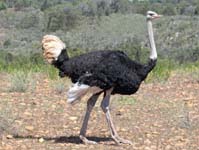
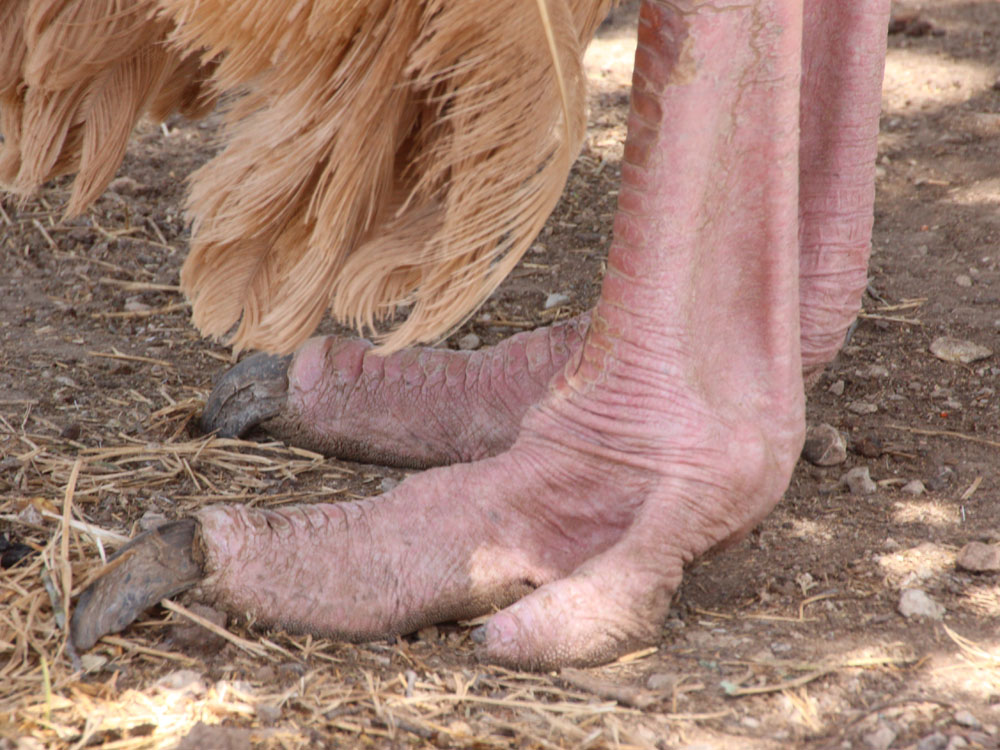
Ostrich,_Somali Struthio molybdophanes
Description: The male Somali ostrich has mainly black plumage with white tail feathers. The female has mainly grey plumage. The skin of the neck and thighs of both sexe is gray-blue, but becomes bright blue on male during mating season. The common ostrich has a pinkish-grey neck compared to the Somali ostrich's bluish-grey neck.
Range: Ethiopia, Kenya, Sudan .
Habitat: Dry grasslands, woodlands, thornbush
Diet: Grass, seeds, leaves; also insects, other invertebrates, small reptiles.
Conservation status: Least Concern.
Image by: 1) Nik_Borrow - Kenya 2) ninara 3) Christiaan_Kooyman 4) Steve_Garvie - KenyaRange: Ethiopia, Kenya, Sudan .
Habitat: Dry grasslands, woodlands, thornbush
Diet: Grass, seeds, leaves; also insects, other invertebrates, small reptiles.
Conservation status: Least Concern.
